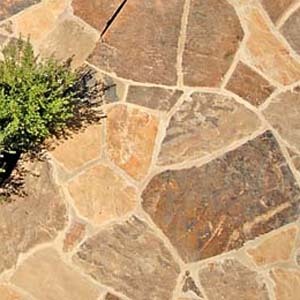Flagstone is one of the most popular rocks for laying walkways for landscaping. It’s relatively flat and the pieces can be shaped to fit just about any combination of twists and turns. Flagstone pieces are usually about a foot long and about an inch thick.
If you want to lay a flagstone walkway, the process is relatively simple. The most important part is planning the scope of the project from the beginning. A straight flagstone walkway will be laid out differently than one that winds and curves, so be sure about the placement before you begin.
You can order flagstone to be delivered to your home from garden centers and landscaping companies, usually measured by the ton or by the cubic yard. It will be delivered on wooden pallets that the delivery man will place in your yard, usually with a forklift. You’ll need to remove the wire mesh surrounding the load, then cart the flagstone to the area of your walkway with a wheelbarrow.
Before you can start to lay your flagstone walkway, however, you’ll need to excavate the area. A flat-ended shovel is usually sufficient for this purpose, as you don’t need to dig deep in order to lay the path. Make sure you remove all sod from the ground as well as any weeds that might be growing, and you should make sure you remove all weeds by the roots.
How deeply you excavate the land will depend on how you want the walkway to look. For example, in our backyard, we lined the sides of the flagstone walkway with landscape edging, then laid sandstone rocks along the path to create a border. Since this raises the pathway to begin with, we didn’t need to create a deep area for the flagstone. You will, however, need to dig about two inches down if you want the flagstone to lay even with the top of the surrounding soil.
After you’ve excavated the land, you’re ready to lay your flagstone walkway. This is largely a matter of searching for the right pieces of stone at the right time. You want the pieces to fit together fairly closely, but two-inch gaps aren’t catastrophic. Think of the flagstone as pieces of a puzzle that you’re attempting to fit together; if a piece doesn’t work, try another one.
The most important thing with this part of the process is you don’t want to have uneven rocks or pieces of flagstone that overlap. It is better to leave a gap than to place one piece atop another. If you’re having trouble getting the stone to lay flat, try leveling the soil underneath with sand or excess top soil.
After you’ve laid your flagstone walkway, survey your work to ensure you are happy with the results. You can always pick up pieces of stone and move them into different positions. If you’re certain that you like how it looks, you’ll need to fill in the gaps.
Peat gravel is a commonly-used substance for this purpose, as are landscaping pebbles. Anything small and sandy will work just fine. The goal is to make one smooth, flat surface out of your flagstone walkway, rather than leaving gaps between the rocks. Pour your gravel or pebbles on top of the walkway, then sweep them into the crevices with a broom. You can add more pebbles as you see fit.
Your flagstone walkway won’t require much maintenance other than ensuring that the joints are always filled with pebbles or peat gravel. You will also have to weed between the joints, even if you lay weed guard.






